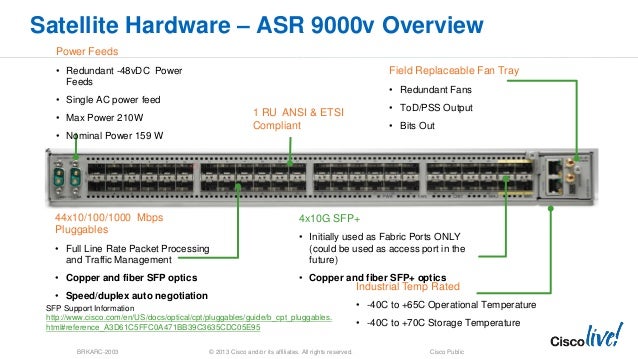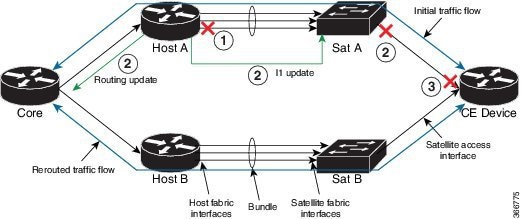The Cisco ASR 9000 product family is widely regarded to be the networking industry’s leading edge routing and switching platform. This blog entry is a quick introductory note on the nV (Network Virtualization) feature set of this product family. In future posts, I will look to go into more details of some of the sub topics.

Installing and Maintaining the Cisco ASR 9000v Satellite Shelf; Installing the Cisco ASR 901 Mobile Wireless Router as a Satellite Shelf; Installing the Cisco ASR 903 Router as a Satellite Shelf; Installing Optional Chassis Accessories; Technical Specifications and Product IDs; Site Log; Cisco ASR 9901, ASR 9001, and ASR 9001-S Routers Hardware. May 23, 2019 The Cisco ASR 9000v and Cisco ASR 9000v-V2 can be deployed adjacent to, or remotely from their Cisco ASR 9000 Series host, supporting applications that require high-density ports, or many remote points of presence. As of December 2012, three separate satellite switches are supported: the ASR 9000v, ASR 901 and ASR 903. The ASR 9000v is a new dedicated satellite switch that can only be used in nV satellite mode along with an ASR9K.
Cisco 9000v Satellite Device
The term “nV” (short for Network Virtualization) on the ASR 9K refers to a set of Virtual Chassis features using which a carrier or enterprise customer can create a single logical switching system using a collection of multiple separate physical chasses. nV consists of two major feature categories: nV Edge and nV Satellite. These two features may be used independently of each other or concurrently.



nV Edge is a feature that allows two separate ASR9K switches to be interconnected via 10G or 100G inter-rack ethernet links and together realize a single larger logical ASR9K switch that has twice the forwarding capacity of each of the individual switches. This is essentially like the Multi-Chassis feature on the Core Routing switch (the CRS family) with the difference that no separate fabric chassis is needed for interconnecting the two ASR9K switches. By using a small number of line side ethernet interfaces as Inter-Rack links a simpler and lower cost multi-chassis solution is realized. Of course all the other benefits of Multi-chassis apply including a true single point of management and control even while getting switch that is essentially functionally identical to a single ASR9K and yet with twice the total throughput. All the carrier class features of the ASR9K and its IOS-XR operating system are preserved while getting a logical or virtual switch that has twice the capacity along with additional network resiliency and geo-redundancy benefits. Network design is also greatly simplified because the number of L2 and L3 routing adjacencies in the network are greatly reduced and the amount of network configuration and management is also much simplified.
Cisco 9000v Satellite Tv
nV Satellite is a feature that allows one or more smaller satellite switches to be interconnected with an ASR9K and together realize an single combined access, aggregation and edge system. This is essentially similar to the Cisco Nexus Fabric Extender solution but with additional enhancements targeted for carrier and service provider market requirements and topologies (the Nexus solutions are focused on the data center networking market requirements). As of December 2012, three separate satellite switches are supported: the ASR 9000v, ASR 901 and ASR 903. The ASR 9000v is a new dedicated satellite switch that can only be used in nV satellite mode along with an ASR9K. The ASR 901 and 903 switches are “dual mode” switches that can operate both as standalone switches (where they run their own independent control and management planes) OR as satellite switches within an nV system with an ASR9K (in which case they are completely managed and controlled by the master ASR9K). In fact the master ASR9K can itself be a cluster of two ASR9Ks running together as an nV Edge system. The feature allows for both redundant and non redundant interconnections between the satellite switches and the master ASR9Ks. The access side ethernet ports of the satellite switches appear within the control and management planes of the host master ASR9K just like locally connected ethernet ports and all features that can be configured on the host ASR9K can also be configured and executed identically on satellite located ports. Effectively the satellite switches are “virtual line cards” of the host ASR9K in every sense. Chassis management functions of the satellites such as software upgrades, inventory and environmental monitoring of hardware sensors (voltage, temperature etc) on the satellites are also seamlessly integrated into the same functions of the host ASR9K just like any other line card of the host ASR9K chassis. These features result in significant benefits for carriers including greatly improved port density per ASR9K line card, reduced network complexity and opex for managing an access + aggregation + edge network and improved access network topology, resiliency and QoS options.
Cisco 9000v Satellite Communicator
The nV solution on the ASR9K is now being extended into a very wide range of network topologies and functionalities, well beyond those summarized by the basic description above. Perhaps more details on these and other topics in future blog entries.

